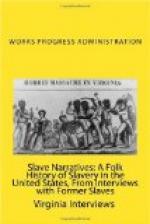Neal. She had the property and married Tom Neal.
She had been married before and her first husband died
but her first husband’s name can’t be recalled.
She had two children—girls—by
her first husband. Her second husband just married
her to protect them all he could. He didn’t
do anything unless the old mistress told him to do
it and how to do it. Wylie Neal was raised up
with the old mistress’ children. He was
born a slave and lived to thirteen years. “The
family had some better to eat and lots more to wear,
but they gave me plenty and never did mistreat me.
They had a peafowl. That was good luck, to keep
some of them about on the place.” They
had guineas, chickens and turkeys. They never
had a farm bell. He never saw one till he came
to Arkansas. They blew a big “Conch shell”
instead. Mistress had cows and she would pour
milk or pot-liquor out in a big pewter bowl on a stump
and the children would come up there from the cabins
and eat [till the field hands had time to cook a meal.][HW:?]
Wylie’s mother was a field hand. They drank
out of tin cans and gourds. The master mated
his hands. Some times he would ask his young man
or woman if they knew anybody they would like to marry
that he was going to buy more help and if they knew
anybody he would buy them if he could. The way
they met folks they would get asked to corn shuckings
and log rollings and Mrs. Neal always took some of
her colored people to church to attend to the stock,
tie the horses and hitch up, maybe feed and to nurse
her little girls at church. The colored folks
sat on the back seats over in a corner together.
If they didn’t behave or talked out they got
a whipping or didn’t go no more. “They
kept the colored people scared to be bad.”
The colored folks believed in hoodoo and witches.
Heard them talking lots about witches. They said
if they found anybody was a witch they would kill
them. Witches took on other forms and went out
to do meaness. They said sometimes some of them
got through latch holes. They used buttons and
door knobs whittled out of wood, and door latches with
strings.
People married early in “Them days”—when
Mistress’ oldest girl married she gave her Sumanthy,
Wylie’s oldest sister when they come home [they
would let her come.] They sent their children to school
some but the colored folks didn’t go because
it was “pay school.” Every year they
had “pertracted meeting.” Looked
like a thousand people come and stayed two or three
weeks along in August, in tents. “We had
a big time then and some times we’d see a colored
girl we’d ask the master to buy. They’d
preach to the colored folks some days. Tell them
the law. How to behave and serve the Lord.”
When Wylie was twelve years old the “Yanks”
came and tore up the farm. “It was just
like these cyclones that is [TR: illegible word]
around here in Arkansas, exactly like that.”




